The Exhibition of the Yokohama Museum of Art: Collection 2015 Part3
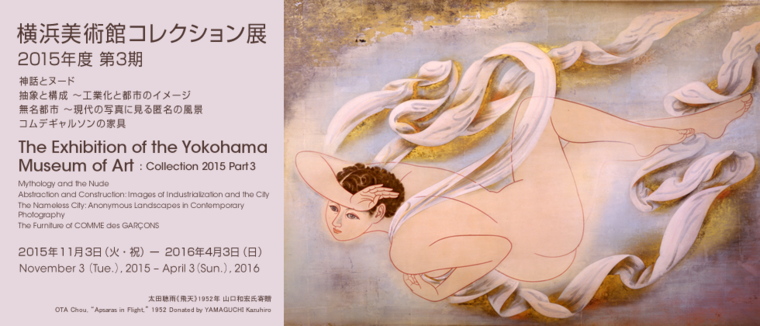
OTA Chou, “Apsaras in Flight,” 1952, donated by YAMAGUCHI Kazuhiro
Highlight
Mythology and the Nude
Abstraction and Construction: Images of Industrialization and the City
The Nameless City: Anonymous Landscapes in Contemporary Photography
The Furniture of COMME des GARÇONS
【Exhibition closed】Yokohama in the Taisho and Showa Periods [Date: Nov.3, 2015-Jan.11, 2016]
The third edition of the Yokohama Museum of Art’s 2015 Collection Exhibition consists of four themes.
In the first, “Mythology and the Nude,” we examine how the depiction of nudity evolved in Europe and Japan in connection with mythology. In Western art, representation of the nude figure can be traced back to ancient Greece, and the depiction of gods and warriors as the embodiment of the ideal human physique. The nude female figure in particular was primarily manifested as the goddess Aphrodite (Venus), the symbol of beauty. The Renaissance saw the beginning of a long period in which the public display of female nudes was only permitted when dealing with a mythological subject. In the modern era, along with the flourishing of avant-garde art movements, these artistic restrictions eased to produce freer and more diverse themes and methods. Here, we present a wide range of nudes in three sections, “Gods as a Symbol of Beauty,” focusing on classical paintings up to the 19th century and pictorial photographs, “Gods as a Symbol of Change and Transformation,” showcasing modern paintings from the West, and “The Sacred and the Profane,” which includes "Nihon-ga" and Japanese contemporary works.
In “Abstraction and Construction: Images of Industrialization and the City,” we focus on the changing urban landscape and artists’ growing interest in machines and manufactured goods as society underwent rapid industrialization at the outset of the 20th century. Along with early 20th century European art movements, such as Constructivism, Dada, and Cubism, the first half, “Constructivism and the City,” is devoted to sculptures made of then new materials like plastic and aluminum, and paintings that incorporate an abstract structure. In the second half, “An Accumulation of Images,” we introduce late 20th-century works by artists who were primarily active in America, including examples of Neo-Dada, which concentrated on the symbolic aspects of industrial images, and Pop Art, which employed images symbolizing popular culture and consumer society that repeatedly appeared in the mass media.
In the next section, “The Nameless City: Anonymous Landscapes in Contemporary Photography,” we turn our attention to the anonymous landscapes depicted in contemporary Japanese photographs and videos, including photographs by NAKAHIRA Takuma, SEINO Yoshiko, YONEDA Tomoko, and a video installation by KANEUJI Teppei. In tandem with this display, we present furniture designed by the world-famous fashion brand COMME des GARÇONS, which has presented works by artists such as NAKAHIRA and SEINO in its flagship store.
In conjunction with the "Nakajima Kiyoshi Retrospective: Exploring the Kaleidoscopic World of an Innovative Nihonga Painter," which runs from November 3, 2015 to January 11, 2016, we present a small exhibit titled “Yokohama in the Taisho and Showa Periods.” Here, we showcase a valuable documentary that was shot in Yokohama some 100 years ago, and makuzu-ware ceramics by MIYAGAWA Kozan and others, which were produced in the city around the same time.
We hope that you will enjoy this exhibition highlighting some of the works in the Yokohama Museum of Art’s diverse collection.
■The Exhibition of the Yokohama Museum of Art : Collection 2015 Part 3
List of works [468KB]
Mythology and the Nude
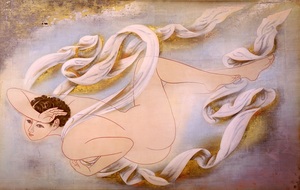
OTA Chou, “Apsaras in Flight,” 1952, donated by YAMAGUCHI Kazuhiro
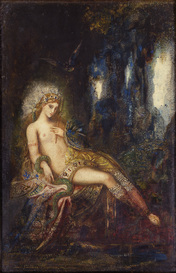
Gustave MOREAU, “Goddess on the Rock,” ca.1890, donated by SAKATA Takeo
Abstraction and Construction: Images of Industrialization and the City
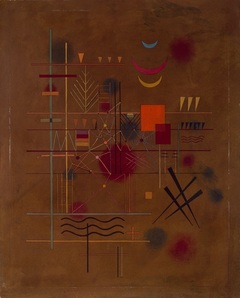
Wassily KANDINSKY, “Red in Nets,” 1927
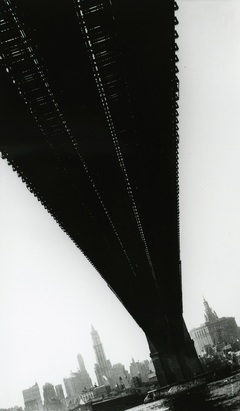
Walker EVANS, "Brooklyn Bridge," ca.1929
In this section, made up of two parts, “Constructivism and the City” and “An Accumulation of Images,” we trace the changing views and expressions of artists in industrial and mass-consumer society from the period between the two world wars to the end of the 20th century.
The Nameless City: Anonymous Landscapes in Contemporary Photography
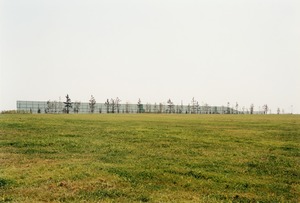
SEINO Yoshiko, "Chiba," (from the series 'The Sign of Life'), 2000, donated by SEINO Yoshitami and Noriko
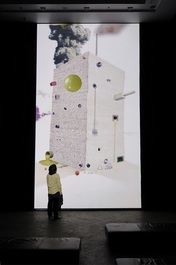
KANEUJI Teppei, “Tower (Movie),” 2009, donated by the artist Photo by Shigeo Muto
Meanwhile, Kaneuji Teppei’s video installation “Tower (Movie)” (2009) is an animated work depicting pulsating buildings with drawings and collages. Here again, the artist assembles existing images to create something with a strong sense of anonymity that lacks any specific cultural context.
The Furniture of COMME des GARÇONS
COMME des GARÇONS, one of Japan’s preeminent fashion brands, was founded by the designer Kawakubo Rei in 1969. It debuted in the Paris Collection in 1981. The company’s innovative designs, which shattered existing concepts of apparel and were referred to at the time as the “Japan shock,” caused a sensation all over the world.
From 1983 to 1991, the brand also produced furniture that was designed by Kawakubo. In addition to having a practical function, these works were used to adorn COMME des GARÇONS shops along with the clothing. Making ample use of pure acrylic and metal mesh – materials that were markedly different from those used in conventional furniture – the works, like COMME des GARÇONS’s clothes, strongly indicated the company’s design orientation.
Moreover, Kawakubo’s creations, which were based on a distinct concept every season and incorporated avant-garde and experimental designs, should be seen in tandem with art of the period. The shop displays, which Kawakubo herself oversaw, featured works by contemporary artists from all over the world alongside COMME des GARÇONS’ clothes. Kawakubo also discovered the photographic genius of Seino Yoshiko, who had originally been an editor, and in 1996, organized her first solo show at the brand’s flagship store. In 2009, Kawakubo also opened an art space called “Six” (a reference to the sixth sense; and a name that the company had also used in its printed matter) in a COMME des GARÇONS shop in Osaka. This was also the site of a solo show by Nakahira Takuma in 2011 (the year that the space closed).
In this section, we present Kawakubo’s furniture in a space that is adorned with works by Seino and Nakahira.
【Exhibition closed】Yokohama in the Taisho and Showa Periods [Date: Nov.3, 2015-Jan.11, 2016]
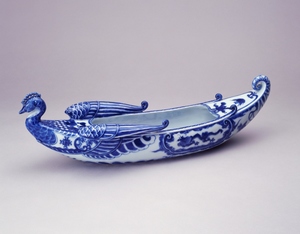
MIYAGAWA Kozan (I), “Vase with Phoenix Design, Underglaze Blue,” ca.1912-16, donated by MAJIMA Matsutaro
Nakajima Kiyoshi was based in Yokohama. He first moved to the city nearly 100 years ago in 1915. The “Shinko” Pier, known for its red-brick warehouses, had just been completed, and in 1917, the Yokohama Port Opening Memorial Hall, one of the city’s “three towers,” was built. This constituted the original form of the modern city of Yokohama, which continues to this day. Yokohama was also being developed into a strategic location for foreign and domestic trade, triggered by the prosperity that accompanied World War I. For example, in 1915, Yokohama Station, which until that time had been on the present-day site of Sakuragicho Station, was moved to Takashima-cho, increasing railroad transport between Tokyo and Yokohama.
Outline
| Dates | November 3 (Tue.), 2015-April 3 (Sun.), 2016 *Exception: Gallery Closed on January 12 (Tue.)-January 29 (Fri.), 2016 |
|---|---|
| Closed | Thursdays (except February 11, 2016), December 29 (Tue.), 2015-January 2 (Sat.), 2016 |
| Open Hours | 10:00-18:00 (Last admission at 17:30) *Open until 20:00 on April 1 and April 2, 2016 (Last admission at 19:30) |
| Organizer | Yokohama Museum of Art |
Ticket
| Adults | 500(400) |
|---|---|
| University students
High school students | 300(240) |
| Junior high school students | 100(80) |
| Children under 12 | Free |
*( )= Group of 20 or more (pre-booking required)
*Free Admission on November 3, 2015
*Free Admission for high school and younger student with valid ID on every Saturday.
*Visitors with disability and one person accompanying them are admitted free of charge.
(Please present certificate at the entrance.)
*Collection gallery is available with ticket of Special Exhibition.









